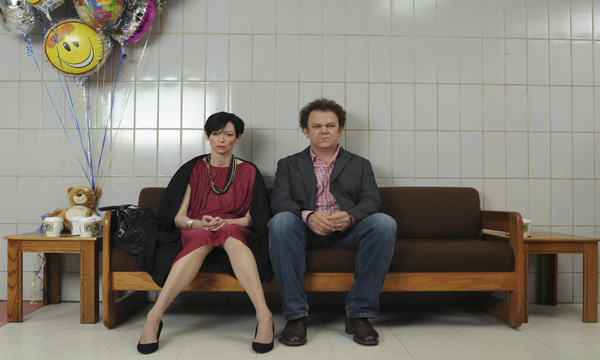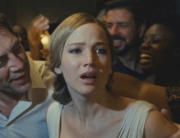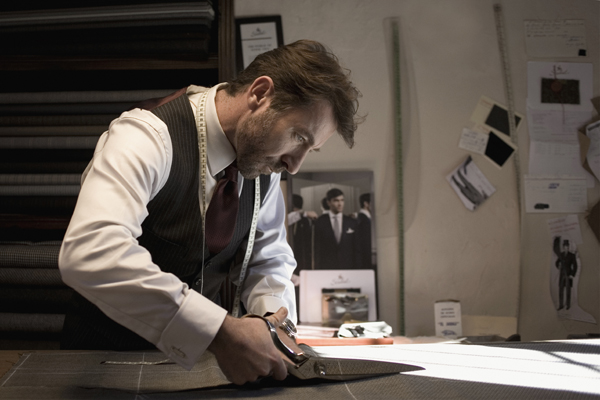
Tilda Swinton and John C. Reilly (Oscilloscope Laboratories)
Mesmerizing on a variety of levels, and boasting some of the finest directing, cinematography, editing, and acting I’ve seen in the past year or more, We Need to Talk About Kevin is one of those films that cinephiles really owe it to themselves to catch.
That said, it remains—how to put this?—an unsatisfying experience, a classic case of the whole not being equal to the sum of its parts. Of course, there are those who might be so dazzled by those individual parts that they’d take exception to such an assessment, and for their arguments I’ve no doubt that they’d find plenty of evidence. For me, it’s a question of expectations. With such tremendous talent working in concert I expected to be blown away, not simply impressed… especially when I’m completely in a film’s thrall for so much of its running time.
Let’s start with director Lynne Ramsay, who turns in another masterful job. I’ll even say that one can’t praise her direction too highly, as Kevin is a film you can watch again fairly soon after an initial viewing, which I’ve done, and discover more and more of its craft and artistry—the countless small gestures, impactful close-ups, and arresting point of view shots that together evoke a sense of unease that throbs just below the surface. Trouble arises only when the material itself forces Ramsay to be somewhat heavy-handed (I’m giving her the benefit of the doubt). Then we get facile shots focusing on the drumming of garish, too-long fingernails, or an obvious and overdone symbolic use of the color red. It’s in this way that we’re left with a bunch of literary-feeling grotesques rather than anything truly disturbing. Yes, Ramsay and everyone else associated with this production do a terrific job in making their film immanently watchable with its canny brand of lurid lyricism, but the problem is that such passages are at odds with what I’d argue is Ramsay’s core skill as a filmmaker: an acutely well-observed rendering of the real.
The degree to which this conflict in sensibility between content and style isn’t bridged is the main issue I have with the film, which tells the story of a monstrous child and the attempts by his mother both to forestall his monstrousness and then to live with its consequences. Based upon a novel by Lionel Shriver that I haven’t read, the screenplay has clear potential even in elevator-pitch form: combine your archetypal bad seed approach with the resonance that school-set rampages hold for today’s audiences. Structuring the script via extremely effective shifts in time, Ramsay and co-writer Rory Kinnear keep us on the hook by revealing the aftermath of Kevin’s crimes on his mother (played flawlessly by Tilda Swinton), while making us wonder at first what those crimes were exactly. It’s compelling stuff, to be sure, and there are some brutally original twists on what we’ve come to expect from teenage violence in the real world.
But that’s about it. Sure, there’s an emotional denouement between the two main characters that’s unexpectedly touching, but I still scratch my head a bit regarding the film’s narrative decisions. At first I admired the way it seemed to be updating all those bad seed tropes—the key word in this regard is “seemed.” Dismayingly, it doesn’t really update anything in terms of how the central dramatic conflict plays out. In fact, it’s often less persuasive in its verisimilitude than other recent entries in the subgenre, such as Joshua (2007) and Orphan (2009), both of which happen to feature Vera Farmiga in the Swinton role. In all of these films, as well as in antecedents such as the original The Bad Seed (1956) and The Omen (1978), it’s the mother who suspects the child of malevolence while the father needs a hefty amount of convincing. Along the way there’s the false front of innocence put on by the evil tyke, an escalation of crimes up to the homicidal level, and the gradual endangerment of any rival siblings. And make no mistake, from these standard ingredients Ramsay and company fashion a highly watchable psychological fable, one that’s at times creepy, at times shocking. But with mounting frustration I kept waiting for the story to do something innovative, to show that it was aware of these similar films and wanted break new ground—and not just stylistically. What if the father (here played by John C. Reilly in a role that’s great to juxtapose thematically with his recent performances in Carnage and Terri) started to believe the mom sooner rather than later? What if the kid had a change of heart and decided to be good? What if on some level the understandable lack of motherly love resulted in some self-fulfilling mechanism that prompts the child’s acts of horror? Suffice it to say, none of things, or anything like them, happens. We Need to Talk About Kevin decides on a path early on and, depressingly, does not deviate from it.
The key difference between it and those aforementioned these films is that we see Kevin progress from troubled infancy up through troubled adolescence. But this is where things become overtly allegorical, and Ramsay’s gifts for portraying the social and historical contexts for childhood in the real world, as in Ratcatcher (1999), are completely ignored. The character of Kevin (Ezra Miller in a terrific performance that I hope earns him a shot at playing a James Bond villain) should remain cloaked in shadows to some extent. However, the story uses this notion to engage in some narrative hand waving that recalls the missing sections of biography in the gospels. Namely, just what happens to our remarkable child in all of those years that we don’t see him, a period that feels close to a decade? Even if his father continues to think the best of him, how does he fool the rest of the world? And more importantly, what prompts him to violence later in high school? There’s a big gap in the middle of the film, an ellipsis that the audience is supposed to fill in as if listening to a fairy tale (“After many years of living in the palace, the little girl grew up to be a princess…”).
No doubt this skipping-around in personal history fits the fever-dream quality that many admire about the film. To me, there’s a missed opportunity. We can certainly have a dark mystery that’s never fully explained—that’s what the character of Kevin represents—but that mystery needs to be workable in its own terms. In short, what’s forgotten is that reality is the most chilling domain of all. If you’re in doubt, consider, or check out, Ben Coccio’s astonishing 2003 film Zero Day, a found footage-style exercise that also involves the eruption of unspeakable teen violence. I’m not suggesting that Kevin’s filmmakers should have embraced such literal-mindedness and thus neglected Ramsay’s poetic inclinations altogether, just that they should not have been so quick to discard it. The result is a film filled with stunning detail and yet oddly lacking in the underpinning that would make us believe in it whole-heartedly.
After all, doesn’t the power of nightmares come from the fact that you think they’re really happening?
















Leave A Comment